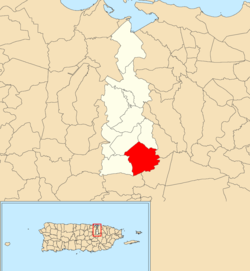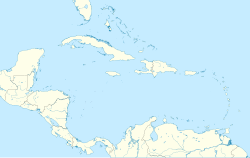Hato Nuevo, Guaynabo, Puerto Rico
Hato Nuevo | |
|---|---|
Barrio | |
 Location of Hato Nuevo within the municipality of Guaynabo shown in red | |
| Coordinates: 18°17′41″N 66°05′59″W / 18.29474°N 66.099629°W[1] | |
| Commonwealth | |
| Municipality | |
| Area | |
| • Total | 3.49 sq mi (9.0 km2) |
| • Land | 3.48 sq mi (9.0 km2) |
| • Water | 0.01 sq mi (0.03 km2) |
| Elevation | 574 ft (175 m) |
| Population (2010) | |
| • Total | 4,114 |
| • Density | 1,182.2/sq mi (456.4/km2) |
| Source: 2010 Census | |
| Time zone | UTC−4 (AST) |
Hato Nuevo is a barrio in the municipality of Guaynabo, Puerto Rico. Its population in 2010 was 4,114.[3][4][5]
Demographics
[edit]| Census | Pop. | Note | %± |
|---|---|---|---|
| 1910 | 877 | — | |
| 1920 | 1,058 | 20.6% | |
| 1930 | 975 | −7.8% | |
| 1940 | 1,094 | 12.2% | |
| 1950 | 1,213 | 10.9% | |
| 1960 | 1,393 | 14.8% | |
| 1970 | 1,666 | 19.6% | |
| 1980 | 2,195 | 31.8% | |
| 1990 | 3,198 | 45.7% | |
| 2000 | 3,115 | −2.6% | |
| 2010 | 4,114 | 32.1% | |
| U.S. Decennial Census 1899 (shown as 1900)[6] 1910-1930[7] 1930-1950[8] 1980-2000[9] 2010[10] | |||
Hurricane Maria
[edit]Hurricane Maria, the deadly Category 5 hurricane that struck Puerto Rico on September 20, 2017,[11] caused flooding and damaged infrastructure in Hato Nuevo. A bridge to replace a collapsed bridge in Hato Nuevo was completed and inaugurated on February 14, 2019, nearly a year and a half later.[12]
Sectors
[edit]Barrios (which are, in contemporary times, roughly comparable to minor civil divisions)[13] in turn are further subdivided into smaller local populated place areas/units called sectores (sectors in English). The types of sectores may vary, from normally sector to urbanización to reparto to barriada to residencial, among others.[14][15][16]
The following sectors are in Hato Nuevo barrio:[17][18]
Brisas del Caribe, Calle Paseo de Matilde, Calle Santa Ana, Camino Los Navarro, Camino Sylvia Rodríguez, Comunidad Alturas de Lomas de Sol, Sector Capó, Sector El Coco, Sector El Faro, Sector El Laberinto, Sector Feliciano, Sector Hato Nuevo II, Sector Inclán, Sector Jorge García, Sector La Pajilla, Sector La Paloma, Sector La Vereda, Sector Limones, Sector Lomas del Sol, Sector O’Neill Casañas, Sector Valle Las Flores, Urbanización Bel-Air, Urbanización Colina Mabó, Urbanización Finca Elena, Urbanización Greenville, Urbanización Lomas del Sol, Urbanización Mountain View, Urbanización Valle Escondido Estates, and Urbanización Villa Mercedes.
See also
[edit]References
[edit]- ^ a b "US Gazetteer 2019". US Census. US Government.
- ^ U.S. Geological Survey Geographic Names Information System: Hato Nuevo barrio
- ^ Picó, Rafael; Buitrago de Santiago, Zayda; Berrios, Hector H. Nueva geografía de Puerto Rico: física, económica, y social, por Rafael Picó. Con la colaboración de Zayda Buitrago de Santiago y Héctor H. Berrios. San Juan Editorial Universitaria, Universidad de Puerto Rico,1969.
- ^ Gwillim Law (20 May 2015). Administrative Subdivisions of Countries: A Comprehensive World Reference, 1900 through 1998. McFarland. p. 300. ISBN 978-1-4766-0447-3. Retrieved 25 December 2018.
- ^ Puerto Rico: 2010 Population and Housing Unit Counts.pdf (PDF). U.S. Dept. of Commerce, Economics and Statistics Administration, U.S. Census Bureau. 2010.
- ^ "Report of the Census of Porto Rico 1899". War Department Office Director Census of Porto Rico. Archived from the original on July 16, 2017. Retrieved September 21, 2017.
- ^ "Table 3-Population of Municipalities: 1930 1920 and 1910" (PDF). United States Census Bureau. Archived (PDF) from the original on August 17, 2017. Retrieved September 21, 2017.
- ^ "Table 4-Area and Population of Municipalities Urban and Rural: 1930 to 1950" (PDF). United States Census Bureau. Archived (PDF) from the original on August 30, 2015. Retrieved September 21, 2014.
- ^ "Table 2 Population and Housing Units: 1960 to 2000" (PDF). United States Census Bureau. Archived (PDF) from the original on July 24, 2017. Retrieved September 21, 2017.
- ^ Puerto Rico: 2010 Population and Housing Unit Counts.pdf (PDF). U.S. Dept. of Commerce Economics and Statistics Administration U.S. Census Bureau. 2010. Archived (PDF) from the original on 2017-02-20. Retrieved 2019-08-02.
- ^ US Department of Commerce, NOAA. "Major Hurricane Maria - September 20, 2017". www.weather.gov. Retrieved 30 June 2019.
- ^ "Inauguran puente en Guaynabo que colapsó durante el paso de María". Primera Hora (in Spanish). 14 February 2019. Retrieved 24 June 2019.
- ^ "US Census Barrio-Pueblo definition". factfinder.com. US Census. Archived from the original on 13 May 2017. Retrieved 5 January 2019.
- ^ "Agencia: Oficina del Coordinador General para el Financiamiento Socioeconómico y la Autogestión (Proposed 2016 Budget)". Puerto Rico Budgets (in Spanish). Retrieved 28 June 2019.
- ^ Rivera Quintero, Marcia (2014), El vuelo de la esperanza: Proyecto de las Comunidades Especiales Puerto Rico, 1997-2004 (first ed.), San Juan, Puerto Rico Fundación Sila M. Calderón, ISBN 978-0-9820806-1-0
- ^ "Leyes del 2001". Lex Juris Puerto Rico (in Spanish). Retrieved 24 June 2020.
- ^ "PRECINTO ELECTORAL GUAYNABO 006" (PDF). Comisión Estatal de Elecciones (in Spanish). PR Government. 21 May 2019. Archived from the original (PDF) on 15 June 2020. Retrieved 20 July 2020.
- ^ "PRECINTO ELECTORAL GUAYNABO 007" (PDF). Comisión Estatal de Elecciones (in Spanish). PR Government. 14 January 2019. Archived from the original (PDF) on 15 June 2020. Retrieved 20 July 2020.
External links
[edit]

